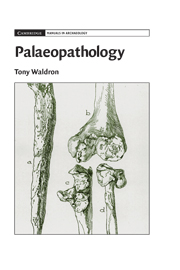Book contents
- Frontmatter
- Contents
- List of Figures
- Preface
- 1 Introduction and Diagnosis
- 2 Bone Metabolism and Pathology
- 3 Diseases of Joints, Part 1
- 4 Diseases of Joints, Part 2
- 5 Bone forming and DISH
- 6 Infectious Diseases
- 7 Metabolic Diseases
- 8 Trauma
- 9 Tumours
- 10 Disorders of Growth and Development
- 11 Soft Tissue Diseases
- 12 Dental Disease
- 13 An Introduction to Epidemiology
- Select Bibliography
- Index
- References
3 - Diseases of Joints, Part 1
Published online by Cambridge University Press: 05 June 2012
- Frontmatter
- Contents
- List of Figures
- Preface
- 1 Introduction and Diagnosis
- 2 Bone Metabolism and Pathology
- 3 Diseases of Joints, Part 1
- 4 Diseases of Joints, Part 2
- 5 Bone forming and DISH
- 6 Infectious Diseases
- 7 Metabolic Diseases
- 8 Trauma
- 9 Tumours
- 10 Disorders of Growth and Development
- 11 Soft Tissue Diseases
- 12 Dental Disease
- 13 An Introduction to Epidemiology
- Select Bibliography
- Index
- References
Summary
There are several different types of joint in the skeleton (Table 3.1). The synovial joints are the most numerous and the only ones commonly affected by disease. Some joints change their appearance with age and these changes are often used by physical anthropologists to help age a skeleton. The pubic symphysis and the auricular surface of the ilium are particularly useful in this regard.
The structure of a typical synovial joint is shown in Figure 3.1. In this type of joint the articulating ends of the bone are held in place by a capsule which is composed externally of a layer of fibrous tissue that varies in thickness partly due to the attachment of ligaments of tendons. The inner layer is composed of the synovial membrane. The capsule is well supplied with blood vessels, lymphatics and nerve endings which may extend down to the synovial membrane.
The articulating ends of the bone are covered with cartilage which varies in thickness from 1–7 mm; it is thicker in larger than in small joints and in joints under considerable stress, such as those of the leg. The cartilage is avascular, has no lymph vessels and is not innervated. The cartilage-forming cells (the chondrocytes) obtain their nutrients by diffusion from fluid within the joint. Articular cartilage provides a moveable surface with an extremely low coefficient of friction, much less than that of two opposing Teflon-coated surfaces.
- Type
- Chapter
- Information
- Palaeopathology , pp. 24 - 45Publisher: Cambridge University PressPrint publication year: 2008
References
- 1
- Cited by

